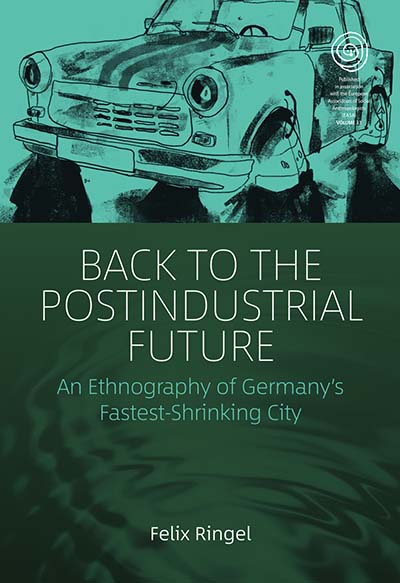
Back to the Postindustrial Future: An Ethnography of Germany’s Fastest-Shrinking City by Felix Ringel
 In 2009, the year after Felix Ringel arrived to conduct his fieldwork in the former socialist model-city, Hoyerswerda received the new, dubious distinction of the fastest-shrinking city in all of Germany. In addition to its rapidly diminishing population—which had halved from approximately 70,000 to fewer than 35,000 in the two decades since the fall of the Berlin Wall—the city also boasted the fastest-aging population of anywhere in the country. These demographic realities combined with the city’s reputation of being “stuck in the past” as both a socialist model-city and as the first city to witness xenophobic attacks against foreigners in 1991, seemed to indicate that Hoyerswerda deserved the moniker of “the city with no future.”
In 2009, the year after Felix Ringel arrived to conduct his fieldwork in the former socialist model-city, Hoyerswerda received the new, dubious distinction of the fastest-shrinking city in all of Germany. In addition to its rapidly diminishing population—which had halved from approximately 70,000 to fewer than 35,000 in the two decades since the fall of the Berlin Wall—the city also boasted the fastest-aging population of anywhere in the country. These demographic realities combined with the city’s reputation of being “stuck in the past” as both a socialist model-city and as the first city to witness xenophobic attacks against foreigners in 1991, seemed to indicate that Hoyerswerda deserved the moniker of “the city with no future.”
Rather than offering “an ethnography of dramatic demise or heroic survival,” however, Felix Ringel’s monograph, Back to the Postindustrial Future: An Ethnography of Germany’s Fastest-Shrinking City, is an ethnography of the future (6). He chronicles Hoyerswerda residents’ efforts not only to cope with the loss of their previously imagined futures, but also to reappropriate hope and their futures in the face of the common perception that their city had neither. Ringel’s central argument is that anthropologists—with the presentist methodology of ethnographic fieldwork at their disposal—are particularly well-suited, and indeed, obligated, to integrate the future as an essential part of anthropological analysis. Throughout the book, Ringel follows his informants’ cue, steering his analytic framework towards the future, just as Hoyerswerda residents oriented themselves in the present towards the future, as opposed to backwards towards the (failed) socialist past.
Ringel’s monograph is divided into five chapters that proceed theoretically and thematically through the content of his fieldwork. Chapter 1 examines and dismisses several academic contexts, demonstrating their limited utility as analytical frameworks for understanding Hoyerswerda’s 2008/2009 present. Ringel shows how the imposition of frameworks such as neoliberalism, postmodernism, globalization, and especially postsocialism. to explain Hoyerswerda’s transformations actually obscure residents’ own attempts to understand their presents and potential futures. Instead Ringel lands on the dominant context of shrinkage—a trope long-associated with the demographically declining city—because “it establishes a clear-cut link to the future as an analytical dimension” (59). The concept and context of shrinkage allows Ringel to push beyond Katherine Verderey’s now-classic questions “What was socialism and what comes next?” Rather, Ringel argues, we should be asking “what was postsocialism and what comes next?” The answer, which comes in the following chapters, is a surprising range of reactions and temporal agency on the part of Hoyerswerda residents that remains unaccounted for if the analytical framework is restricted to a postsocialist context.
Building on the methodological interventions of anthropologists like Jane Guyer, in Chapter 2 Ringel elucidates several examples from his fieldwork that show how citizens of the shrinking city exercise “temporal flexibility” in response to their problematic present. As Ringel aptly puts it, “because the process of shrinkage has profoundly challenged its inhabitants’ self-understanding, manifold ideas, interpretations and imaginations drawn from different pasts and directed towards competing future visions have become essential tools for dealing with the current changes” (69). One rich example of this is illustrated by Ringel’s discussion of the politically competing local youth organizations, one expressly neo-Nazi and the other openly leftist. On several occasions throughout his fieldwork Ringel had cause to observe the interaction between these two groups and the vastly different temporal reasoning they exhibited in their competing visions of the future. Although both groups shared a reference to the Nazi past as either neo-Nazis or anti-Fascists, the right-wing groups harnessed the Nazi past to predict the inevitable death of the German people (Volkstod) under the yoke of the democratic system. Contrarily, the local anti-Fascist (Antifa) movement avoided reference to dystopian or utopian pasts or futures altogether, instead focusing on the local administration’s shortcomings in commemorating more recent xenophobic attacks. In other words, Ringel shows how “different understandings of the past, evoked in different settings, groups and situations of conflict, also translate into different perspectives on the present and future” (85).
The theoretical groundwork laid in the first two chapters prepares the reader for a close-up examination of two different case studies of local futurity. Chapter 3 offers further examples of “temporal flexibility.” Throughout the chapter Ringel focuses on three groups of actors in Hoyerswerda’s local political scene: those responsible for the city’s deconstruction (Rückbau), the architectural elite during the GDR, and the current sociocultural elite. He shows how each of these groups initially exhibited an “evacuation of the near future,” while ultimately questioning and partially overcoming this evacuation. Put differently, though the context of postsocialism seemed to impose a bleak and restrictive near future on the inhabitants of Hoyerswerda, all three groups and ordinary citizens alike evinced creative approaches to solving the city’s short and long-term problems, thus bypassing and in so doing reclaiming the near future. Chapter 4, in turn, focuses not on specific forms of temporal reasoning, rather on “claim[s] that the anticipation of the yet-to-come comprises particular investments of reason and affect” (118). Take for example Hoyerswerda city government’s attempts to construct a coherent Leitbild (a “leading image” or general development plan). According to Ringel, the exercise of producing and disseminating this representational vision of the future was “purely affective, intending to provoke a feeling of security, optimism, and other feelgood emotions and affects, especially hope” (141). As a whole the chapter demonstrates that the enforced futurism and presentism of the local city government were fortunately often overcome by Hoyerswerda residents’ actual temporal agency in “relat[ing] to the future without falling prey to petty politics, cramped pedagogies or short-term, superficial marketing logics” (144).
Finally, Chapter 5 further maps the local economy of knowledge about the future by offering a couple extended examples of residents’ quest for endurance. One extended ethnographic vignette expertly reconstructs Hoyerswerda residents’ attempts to save one of the city’s oldest and most popular buildings, Braugasse Nr. 1, from potential demolition, or at the very least an uncertain and unoccupied future. The extended debate on how the space of the renovated building would be best utilized in the future demonstrates how “the temporal dimension of the future played an important role in many communal practices in a city that faces constant (involuntary) change” because “it was the central focus of this urban community’s many collective attempts at getting a grip on its problematic, supposedly futureless present” (158).
Ringel’s captivating monograph will be of specific interest to anthropologists, especially those working on issues of temporality and the future. Scholars of postsocialist (or postpostsocialist) East Central Europe, and specifically Germany, from various fields will likewise find many of Ringel’s questions and methodology compelling, not to mention his colorful ethnographic vignettes. Ringel’s call to “treat the past and future symmetrically in anthropological analysis, paying in-depth attention to all the temporal relations and experiences—pertaining to the past, present, and future—found in our fieldsites’ many successive presents” is among his most crucial interventions. As a historian studying another formerly socialist model-city, I also find Ringel’s concept of “temporal flexibility” a particularly effective way to grasp residents’ varying strategies of harnessing the past in service of understanding their presents or navigating their futures.
In his account of Hoyerswerda’s 2008/2009 present, Ringel makes a concerted effort to “refrain from extensively describing disappearance, absence, change and hopelessness or the ongoing process of spatial and material deterioration, decay and deconstruction of lifeworlds and former socialist and postsocialist living paces,” instead privileging the “specific local clashes in—and through—which particular knowledge about the city and its future is made explicit” (18-19). But it is clear throughout the book in descriptions of his ethnographic encounters that these tangible effects of shrinkage were near omnipresent. Take for example the international artists’ residency program, ‘Artblock,’ that occupied Wohnkomplex 10 (Housing Complex 10) before its demolition, or the loaded discussions about which organizations would find a new home once the Braugasse Nr. 1 building was finally renovated. As the physical and material manifestation of shrinkage, I wonder whether we lose more than we gain by excluding these visceral reminders of the decaying socialist and postsocialist pasts, as they no doubt often served to make worries about the present and future of Hoyerswerda all the more acute. For although Ringel ostensibly eschews “historically-minded” accounts of postsocialist transformation for an epistemological prioritization the future (8), his book nonetheless masterfully captures the tension in Hoyerswerda residents’ lives as they navigate the interplay between their socialist pasts, their evolving postsocialist presents, and their potential postindustrial futures.
Reviewed by Larissa Stiglich, University of North Carolina at Chapel Hill
Back to the Postindustrial Future: An Ethnography of Germany’s Fastest-Shrinking City
By Felix Ringel
Publisher: Berghahn Books
Hardcover / 238 pages / 2018
ISBN: 978-1-78533-798-7
To read more book reviews, please click here.
Published on July, 2 2018.




